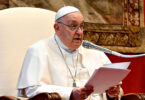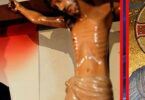February 17, 2019 by Rebecca Bratten Weiss
Today the news broke that Cardinal Theodore McCarrick, accused of assaulting minors and harassing adults, was laicized by the Vatican: the first time in history that a cardinal has been removed from his clerical state for sexual abuse.
Many, hearing this news, have said: this is just the beginning: because McCarrick is only one man. Because there are thousands of others.
And because the problem is systemic, with deep roots in the church’s history. And it’s not just the church. The problem of sexual abuse and cover-up is widespread, from conservative religious groups to liberal Hollywood. It’s not a new thing, either, that can be blithely pinned on the secular revolution or any specifically modern phenomenon. The history of civilization is a history of male authority, upheld by violence, and sexual violence is an integral aspect of the mechanism of patriarchal control.
While this is most frequently seen as male violence against women – look at our most formative texts of western civilization, the Iliad and the Old Testament – male sexual violence has also repeatedly been enacted as a form of domination, aggression, and punishment of other men. That means that yes, gay men can be as aggressive and abusive to other men as straight men can be to women. It also means that non-gay men can also be sexually aggressive to other men.
Contrary to what some conservatives in the church want us to believe, it’s not only gay men – and it’s not a gay problem.
The problem has to do rather with a connection between male power and sexual entitlement, which is also why for much of history legal marriage was often closer to legal sex slavery than to the relationship of affection, mutuality, and consent we uphold today.
Sex as male dominance is seen specifically in the phenomenon of punitive or dominative rape of males by other males who don’t identify as gay. As a matter of fact, the strict delineation of gay / straight, or homo / hetero, is fairly recent. Sexuality used to be viewed, if at all, as much more fluid, in many cultures. In ancient Rome, for instance, there was no set conception of homosexuality, but there was a strong belief in male authority. This male authority meant male sexual privilege, and this privilege meant that a ruling male could legally force himself not only on his wife but also on slaves, concubines, prostitutes, and entertainers – of either gender.
The crucial issue was not the gender of his partner, but only that he, the male, remain the “top” in the relationship. We see something similar in the mechanisms of prison culture today.
What makes this especially problematic for the church is that rather than working for equality, we have enshrined and anointed male authority.
For all the talk of the priesthood not being an institution of power, the reality is that the church is in thrall to a culture of radical clericalism. It’s not just that the priest has the power to preside over the sacrament of the Eucharist – he presides over every other sacrament as well. The Magisterium, charged with the responsibility of teaching and developing doctrine, is made up exclusively of priests. Political decisions are made by priests. Only a priest can be made pope. Priests rule over parishes, religious communities, universities, and schools. They control the money, the property, the liturgy, the rules, and our very bodies.
Priests are taken as authorities even on topics they know nothing about. How often in discussion has someone backed up a bizarre assertion with the claim that “a holy priest I know told me this”? We’re told we mustn’t disagree with priests, must always support them, never criticize them.
When we look at the spectacle of the priests, bishops, and cardinals of the church, we see ornate robes and expensive finery – a procession of kings and princes. Throughout church history, popes and bishops have wielded the power of kings – even commanding armies. And yes, frequently having sexual partners.
Where is Jesus in all of this?
The humble carpenter who walked from town to town, who conversed with the marginalized, and who even in his one – ironic – moment of triumph rode a humble donkey seems to have nothing to do with this culture of princely clericalism and unchecked authority. Jesus, who said the last would be first, and extolled the meek and the downtrodden, seems to be very far from these theatrics.
And, lest I be misunderstood: it’s not the aesthetic that bothers me. I like beautiful art, majestic architecture, and the sacred music that sounds like the voices of the angels. To enter into a beautiful gothic or Baroque cathedral as though walking into our own home is to be reminded that the kingdom belongs to all of us.
But clerical culture seems to be saying:no, not really. Not to all of us equally.
I have met some really wonderful priests, wise and humble men. In most cases, I didn’t even know they were priests at first, because they didn’t approach me with a lot of pompous preening. I especially admire them because it seems they’ve resisted the impulses of a culture seems to invite men who enter the priesthood to become increasingly weirder, creepier, more arrogant, and out of touch.
The Gospel of Jesus was all about overturning power structures – beginning with his mother Mary’s revolutionary Magnificat. Jesus repeatedly undermined systems of dominance, and in so doing became a teacher that not only men but also women could follow with love and trust. This should have set the foundation for a religious tradition of radical egalitarianism which – even given our invitable human flaws and limitations – would have pushed back, consistently, against the culture of male dominance which justified the oppression and use of women, and in which sex ended up always being tied up with power.
Instead, the Roman Catholic church seems to have compounded the problem, by adding to political and anthropological superiority a dimension of sacerdotal authority against which any objectors, male or female, are helpless to protest.
Given this reality, seeming so contrary to what Jesus intended, the kind of reform the church needs is going to have to be far more radical than the laicization of one – or even one hundred – cardinals.
This isn’t even the beginning of a beginning.
image credit: https://commons.wikimedia.org/wiki/File:Cardinal_Burke_Ordinations.jpg
Views: 0







